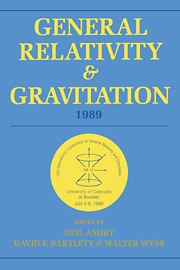 General Relativity and Gravitation, 1989
General Relativity and Gravitation, 1989 Book contents
- Frontmatter
- Contents
- Preface
- Conference committees
- Part A Classical relativity and gravitation theory
- WORKSHOPS
- Part B Relativistic astrophysics, early universe, and classical cosmology
- WORKSHOPS
- Part C Experimental gravitation and gravitational wave detection
- WORKSHOPS
- Part D Quantum gravity, superstrings, quantum cosmology
- 14 Self-duality, quantum gravity, Wilson loops and all that
- 15 Progress in quantum cosmology
- 16 String theory as a quantum theory of gravity
- WORKSHOPS
- Part E Overviews-past, present, and future
14 - Self-duality, quantum gravity, Wilson loops and all that
Published online by Cambridge University Press: 05 March 2012
- Frontmatter
- Contents
- Preface
- Conference committees
- Part A Classical relativity and gravitation theory
- WORKSHOPS
- Part B Relativistic astrophysics, early universe, and classical cosmology
- WORKSHOPS
- Part C Experimental gravitation and gravitational wave detection
- WORKSHOPS
- Part D Quantum gravity, superstrings, quantum cosmology
- 14 Self-duality, quantum gravity, Wilson loops and all that
- 15 Progress in quantum cosmology
- 16 String theory as a quantum theory of gravity
- WORKSHOPS
- Part E Overviews-past, present, and future
Summary
Introduction
At the Padova GRG conference, a new avenue to non-perturbative, canonical quantum gravity was suggested (Newman (1984)). By the time the Stockholm conference was held, these preliminary ideas had blossomed into a broad program aimed at analysing the structure of classical and quantum general relativity from a somewhat unusual standpoint (Ashtekar (1986), (1987)). By now, over two dozen individuals have contributed to this program. The purpose of this chapter is to present a brief status report of this body of ideas. Although I will try to be objective, it is inevitable that not everyone who is working in this field will agree with all the views expressed here. Also, since my space is limited, I will have to leave out several interesting results; I apologize in advance for these omissions.
The key idea underlying this program is to shift the emphasis from geometrodynamics to connection dynamics. In the classical theory, the new viewpoint merely complements the traditional one in which the metric, rather than a connection, is taken as the fundamental variable. We do obtain a fresh perspective that simplifies certain issues and suggests new ways of tackling unresolved problems. However, as far as the basic features of the theory are concerned, nothing is really altered conceptually. It is in the quantum regime that the shift of emphasis plays a major role. More precisely, there are indications that connection dynamics is indeed a better tool to analyze the micro-structure of space-time in a non-perturbative way.
- Type
- Chapter
- Information
- General Relativity and Gravitation, 1989Proceedings of the 12th International Conference on General Relativity and Gravitation, pp. 369 - 390Publisher: Cambridge University PressPrint publication year: 1990


